The popularity of electric vehicles is, for the moment, inversely proportional to the media space they receive. That said, that popularity is growing exponentially, and many consumers claim they are at least considering some type of electrified vehicle next time around. Here are two solutions that sit at the midpoint between 100% electric and conventional hybrid vehicles. For those who want an environmentally friendly ride without suffering from dead battery syndrome, otherwise known as range anxiety…
2019 Hyundai IONIQ PHEV
Hyundai was the first manufacturer to offer a green solution in three flavors with the IONIQ. Offered in hybrid, plug-in hybrid and 100% electric this round-shaped car wants to reach everyone. Built on the same basis as the electric version, the IONIQ Electric Plus incorporates a gasoline engine to extend both the range of this vehicle and its appeal to consumers. While the first two models of IONIQ arrived on the market in 2017, Electric Plus arrived in 2018
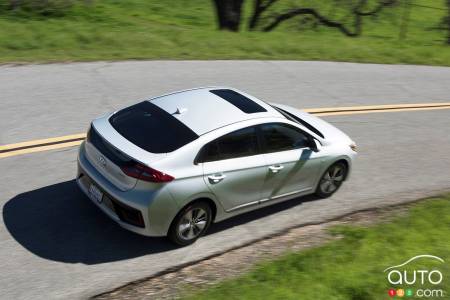
Under the hood
A 1.6L 4-cylinder gasoline engine is paired with an 8.9 kWh battery that together provides 164 hp and 139 lb-ft of torque. At full charge, the battery alone can give you around 47 km of range on a sunny summer day, with no wind. Hyundai says that combined gas/electric range is around 1,000 km. Our week behind the wheel gave us average fuel consumption between 4L and 4.5L/100 km.
Two versions
The entry-level model, called Preferred, comes standard with 16-inch alloy wheels, automatic headlamps, heated side-view mirrors, heated front seats, manual front seat adjustments, a six-speaker stereo system with a 7.0-inch multimedia display and Apple CarPlay and Android Auto integration.
Also included is cruise control, dual-zone automatic climate control, 4.2-inch digital gauge digital display, LED daytime running lights and taillights, at eight power settings driver's seat, heated rear seats, passive remote entry, sunroof, blind spots monitoring with lane assistance and rear cross traffic alert.
The Ultimate version adds a higher quality audio system, leather upholstery, auto-dimming rear view mirror, adaptive cruise control, rear parking sensors, lane keeping assist and forward collision alert with auto brake and pedestrian warning.
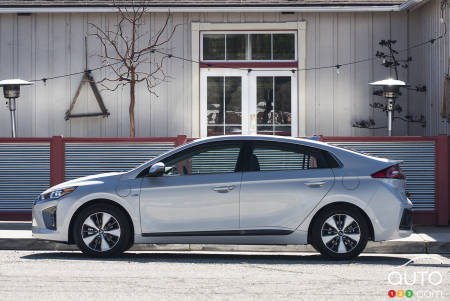
Positive drive
Point one on this front is that Hyundai, unlike the majority of its competitors, has opted for a six-speed automatic dual-clutch transmission. This single point makes the car a lot more fun to drive than a boring CVT. The comfortable seats and the well calibrated suspension that does not show too much roll are also a plus. The only weak point lies in the spongy braking which lengthens stopping distances.
The cargo space is generous with its tailgate that offers 650 litres of space, a little less than the hybrid model because of the batteries that consume some space.
Consult our listing of pre-owned Hyundai vehicles available in your region of Canada
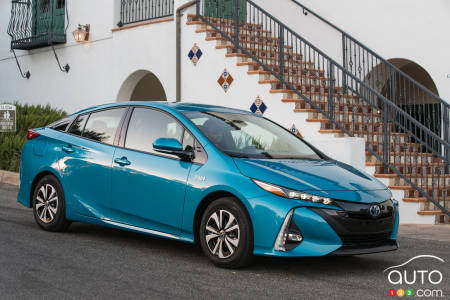
2019 Toyota Prius Prime
Toyota, recognized for its concern for the environment, was the first manufacturer to market a hybrid model on a large scale. But, surprisingly, the Prius Prime is the only plug-in model at Toyota. A funny thing, when we know how fast the green energy market is developing.
A Prius, but with more range
The Prius Prime builds on the regular Prius, but adds a larger capacity battery that can be charged. The current model was born in 2017. For 2020, the model is entitled to some updates such as the addition of Apple CarPlay (no Android auto) and two new USB ports for the rear cabin and black interior accents (replacing the white) .
Under the hood
The Prius Prime comes with the same 4-cylinder 1.8-liter Atkinson-cycle engine that sits in the regular Prius, with an 8.8 kWh electric motor versus the 8.9-kWh unit for the IONIQ. The combined output of the two engines is 121 hp and 142 lb-ft of torque. This power is delivered to the front wheels via a CVT gearbox. Once charged, the Prime can be driven in purely electric mode a little more than 40 km - the same as the IONIQ.
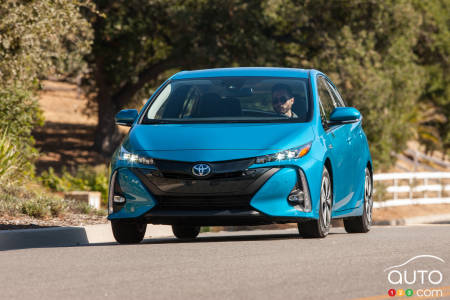
More high-tech
The Prime comes in three versions: Plus, Premium and Advanced. Out of the box you get LED headlights and taillights, a keyless passive entry (only for the driver's door), automatic climate control, a heated steering wheel with synthetic leather trim, a 6-speaker audio system with 7.0-inch touchscreen, 6-way manual-adjustable fabric-covered seats for driver and front passenger, heated front seats and power windows with auto up/down button
As for drive assist systems, there’s cruise control, front-end collision detection with pedestrian detection with automatic braking, lane departure warning, automatic high beam and dynamic radar speed controller.
The Premium version features a 11.6-inch centre screen with navigation, softex padding and an power-adjustable driver seat.
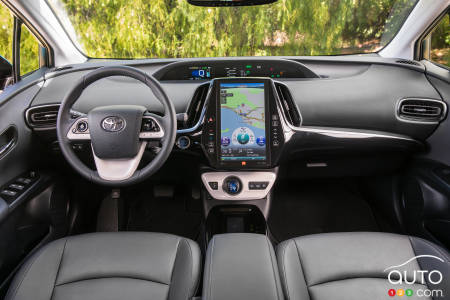
The Advanced trim adds a 10-speaker audio system, park assist, parking sensors, head-up display, fog lights, auto-dimming rearview mirror, garage-door opener, blind spot monitor with cross-traffic alert and rain-detecting windshield wipers.
On the road
Since the Prius received Toyota’s the TNGA platform, it’s manifestly more interesting to drive. It benefits from a stiffer structure, a lower centre of gravity thanks to the new chassis and a quieter cabin due to improved sound insulation. The comfort of the seats also compares very well with those in its Hyundai rival. The only difference is in the CVT transmission that we still have trouble warming up to. IONIQ scores points on that front. However, the Prius’ brakes are a touch superior. Overall the two models fight to a virtual draw in terms of the driving experience they deliver.
Consult our listing of pre-owned Toyota Prius vehicles available in your region of Canada

Advantage IONIQ Electric Plus
For those who want a little more space, note that the IONIQ is more generous in interior space than the Prius and also offers a little more space in the trunk (650 litres vs 612). We also liked the dual-clutch automatic transmission, substantially more enjoyable than the CVT. The IONIQ also offers better overall power. The Korean model is also more generous about the standard equipment it comes with, and you have both Apple CarPlay and Android Auto. The latter is missing in the Prius Prime. The IONIQ’S warranty is superior.
Advantage Prius Prime
The Toyota’s interior is more modern, especially if you opt for the 11.6-inch screen that gives an almost futuristic look to the cabin. For those who often in a hurry, the Prius Prime accepts rapid charging, which is not the case with the IONIQ Electric Plus.
Similarities
There are in fact many similarities between these two evenly matched models. The distance that can be traveled on a full charge is almost the same; total range exceeds 1,000 km in both models. Fuel consumption is also very similar, and both have proven to be quite reliable. In both cases, you are also entitled to $ 4,000 in provincial government rebates and $ 2,500 in federal rebates.
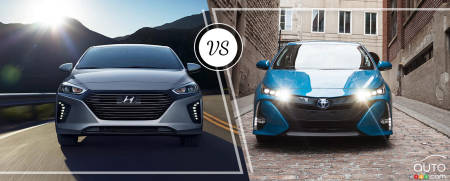
Verdict
For the superior available power and for the able and pleasant dual-clutch automatic transmission, our vote goes to the IONIQ, which features more standard equipment and has a longer warranty to boot. However, this is as much a question of personal preference as anything. Both cars have an excellent reliability record and frankly neither model is a bad choice in the category.
2019 Hyundai IONIQ Electric Plus
We like
Fun to drive
Interior space
Sequential gearbox
We like less
Rear visibility
Less space for the head in the backseat
Shy on electric ranger
2019 Toyota Prius Prime
We like
Historically reliable
Contemporary cabin
Lower retail price
We like less
Shy on electrix range
CVT gearbox
No Android Auto

Specifications
| ... | 2019 Hyundai IONIQ Electric Plus | 2019 Toyota Prius Prime | |
| Transmission | 6-speed sequential | CVT | |
| Drivetrain | FWD | FWD | |
| Fuel consumption (city) | 4.3 L/100 km | 4.4 L/100 km | |
| Fuel consumption (highway) | 4.4 L/100 km | 4.6 L/100 km | |
| Engine | |||
| Type | Gas-electric | Gas-electric | |
| Output | 164 hp | 136 hhp | |
| Torque | 139 lb-ft | 142 lb-ft | |
| Cylinders | 4 | 4 | |
| Displacement | 1.6 L | 1.8 L | |
| Capacity | |||
| Cargo Space | 650 L | 612 L | |
| Fuel tank | 43 L | 43 L | |
| Dimensions | |||
| Length | 4470 mm | 4480 mm | |
| Width | 1820 mm | 1745 mm | |
| Height | 1445 mm | 1490 mm | |
| Wheelbase | 2700 mm | 2700 mm | |
| Warranty | 5 years/100,000 km | 3 years/60,000 km | |
| Prices | $34,603 to $39,103 | $35,234 to $38,359 | |



